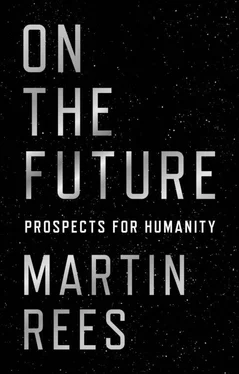Despite the uncertainties—both in the science and in population and economic projections—two messages are important:
1. Regional disruptions in weather patterns within the next twenty to thirty years will aggravate pressures on food and water, cause more ‘extreme events’, and engender migration.
2. Under ‘business as usual’ scenarios in which the world continues to depend on fossil fuels, we can’t rule out, later in the century, really catastrophic warming, and tipping points triggering long-term trends like the melting of Greenland’s ice cap.
But even those who accept both these statements and agree that there’s a significant risk of climate catastrophe a century hence, will differ in how urgently they advocate action today. Their assessment will depend on expectations of future growth and optimism about technological fixes. Above all, however, it depends on an ethical issue—the extent to which we should limit our own gratification for the benefit of future generations.
Bjørn Lomborg achieved prominence (along with ‘bogyman status’ among many climate scientists) through his book The Skeptical Environmentalist . He has convened a Copenhagen Consensus of economists to pronounce on global problems and policy. [14]These economists apply a standard discount rate, thereby in effect writing off what happens beyond 2050. There is indeed little risk of catastrophe within that time horizon, so unsurprisingly they downplay the priority of addressing climate change compared to other ways of helping the world’s poor. But, as Nicholas Stern [15]and Martin Woltzman [16]would argue, if you apply a lower discount rate—and, in effect, don’t discriminate on grounds of date of birth and care about those who’ll live into the twenty-second century and beyond—then you may deem it worth making an investment now to protect those future generations against the worst-case scenario.
Consider this analogy. Suppose astronomers had tracked an asteroid and calculated that it would hit the Earth in 2100, not with certainty, but with (say) 10 percent probability. Would we relax, saying that it’s a problem that can be set on one side for fifty years—people will then be richer, and it may turn out then that it’s going to miss the Earth anyway? I don’t think we would. There would be a consensus that we should start straight away and do our damnedest to find ways to deflect it or mitigate its effects. We’d realise that most of today’s young children will still be alive in 2100, and we care about them.
(As a parenthesis, I’d note that there’s one policy context when an essentially zero discount rate is applied: radioactive waste disposal, where the depositories deep underground, such as that being constructed at Onkalo in Finland, and proposed [but then aborted] under Yucca Mountain in the United States, are required to prevent leakage for ten thousand or even a million years—somewhat ironic when we can’t plan the rest of energy policy even thirty years ahead.)
1.6. CLEAN ENERGY—AND A ‘PLAN B’?
Why do governments respond with torpor to the climate threat? It is mainly because concerns about future generations (and about people in poorer parts of the world) tend to slip down the agenda. Indeed, the difficulty of impelling CO 2reductions (by, for instance, a carbon tax) is that the impact of any action not only lies decades ahead but also is globally diffused. The pledges made at the 2015 Paris conference, with a commitment to renew and revise them every five years, are a positive step. But the issues that gained prominence during that conference will slip down the agenda again unless there’s continuing public concern—unless the issues still show up in politicians’ in-boxes and in the press.
In the 1960s the Stanford University psychologist Walter Mischel did some classic experiments. He offered children a choice: one marshmallow immediately, or two if they waited for fifteen minutes. He claimed that the children who chose to delay their gratification became happier and more successful adults. [17]This is an apt metaphor for the dilemma nations face today. If short-term payback—instant gratification—is prioritised, then the welfare of future generations is jeopardised. The planning horizon for infrastructure and environmental policies needs to stretch fifty or more years into the future. If you care about future generations, it isn’t ethical to discount future benefits (and dis-benefits) at the same rate as you would if you were a property developer planning an office building. And this rate of discounting is a crucial factor in the climate-policy debate.
Many still hope that our civilisation can segue smoothly towards a low-carbon future. But politicians won’t gain much resonance by advocating a bare-bones approach that entails unwelcome lifestyle changes—especially if the benefits are far away and decades into the future. Indeed, it is easier to gain support for adaptation to climate change rather than mitigation because the benefits of the former accrue locally. For instance, the government of Cuba, whose coastal areas are especially vulnerable to hurricanes and a rise in sea level, has formulated a carefully worked-out plan stretching for a century. [18]
Nonetheless, three measures that could mitigate climate change seem politically realistic—indeed, almost ‘win-win’.
First, all countries could improve energy efficiency and thereby actually save money. There could be incentives to ensure ‘greener’ design of buildings. This is not just a matter of improved insulation—it requires re-thinking construction as well. To take one example, when a building is demolished, some of its elements—steel girders and plastic piping, for instance—will hardly have degraded and could be reused. Moreover, girders could be more cleverly designed at the outset so as to offer the same strength with less weight, thereby saving on steel production. This exemplifies a concept that is gaining traction: the circular economy—where the aim is to recycle as much material as possible. [19]
Often, technical advances make appliances more efficient. It would then make sense to scrap the old ones, but only if the efficiency gain is at least enough to compensate for the extra cost of manufacturing the updated version. Appliances and vehicles could be designed in a more modular way so that they could be readily upgraded by replacing parts rather than by being thrown away. Electric cars could be encouraged—and could be dominant by 2040. This transition would reduce pollution (and noise) in cities. But its effect on CO 2levels depends, of course, on where the electricity comes from that charges the batteries.
Effective action needs a change in mind-set. We need to value long-lasting things—and urge producers and retailers to highlight durability. We need to repair and upgrade rather than replace. Or do without. Token reductions may make us feel virtuous but won’t be enough—if everyone does a little, we’ll only achieve a little.
A second ‘win-win’ policy would target cuts to methane, black carbon, and CFC emissions. These are subsidiary contributors to greenhouse warming. But unlike CO 2they cause local pollution too—in Chinese cities, for instance—so there’s a stronger incentive to reduce them. (In European countries the effort to reduce pollution starts off with a handicap. In the 1990s there was pressure in favour of diesel cars because of their greater fuel economy. This is only now being reversed because they emit polluting microparticles that endanger healthy living in cities.)
But the third measure is the most crucial. Nations should expand Research and Development (R&D) into all forms of low-carbon energy generation (renewables, fourth-generation nuclear, fusion, and the rest), and into other technologies where parallel progress is crucial—especially storage and smart grids. That is why an encouraging outcome of the 2015 Paris conference was an initiative called Mission Innovation. It was launched by President Obama and by the Indian prime minister, Narendra Modi, and endorsed by the countries of the G7 plus India, China, and eleven other nations. It is hoped they’ll pledge to double their publicly funded R&D into clean energy by 2020 and to coordinate efforts. This target is a modest one. Presently, only 2 percent of publicly funded R&D is devoted to these challenges. Why shouldn’t the percentage be comparable to spending on medical or defence research? Bill Gates and other private philanthropists have pledged a parallel commitment.
Читать дальше


![Мартин Рис - Всего шесть чисел. Главные силы, формирующие Вселенную [litres]](/books/414169/martin-ris-vsego-shest-chisel-glavnye-sily-formir-thumb.webp)









